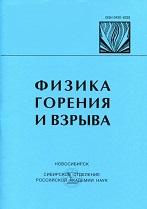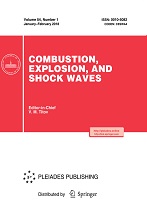|
This article is cited in 11 scientific papers (total in 11 papers)
Mechanism of combustion catalysis by ferrocene derivatives. 2. Combustion of ammonium perchlorate-based propellants with ferrocene derivatives
V. P. Sinditskii, A. N. Chernyi, D. A. Marchenkov
D. Mendeleev University of Chemical Technology of Russia, Moscow, 125047, Russia
Abstract:
Combustion of mixtures of a narrow fraction of ammonium perchlorate (AP) with hydrocarbon binders and combustion catalysts diethylferrocene and 1,1'-bis(dimethyloctyloxysilyl)ferrocene, as well as nano-sized Fe$_3$O$_3$ is studied. It is shown that the efficiency of ferrocene compounds from the viewpoint of increasing the burning rate depends on the oxidizer/fuel ratio in the propellant and on the place of the leading reaction of combustion. In composites with a high oxidizer/fuel ratio whose combustion follows the gas-phase model, the catalyst efficiency is rather low. In systems with a low oxidizer/fuel ratio where the contribution of condensed-phase reactions to the burning rate of the system is rather large, the catalyst efficiency is noticeably greater, and it is directly related to the possibility of formation of a soot skeleton during combustion. The close values of the catalytic activity of ferrocenes and Fe$_2$O$_3$ in the case of their small concentrations in such compositions testify that the main contribution to the increase in the propellant burning rate is made by Fe$_2$O$_3$ formed due to rapid oxidation of ferrocene on the AP surface and accumulated on the soot skeleton. Thermocouple measurements of propellants with a low oxidizer/fuel ratio are performed, and it is shown that the temperature of their surface is determined by plasticizer evaporation. A phenomenological model of combustion of the examined propellants is proposed.
Keywords:
mechanism of catalysis, diethylferrocene, ammonium perchlorate, combustion, catalyst.
Received: 10.06.2013
Citation:
V. P. Sinditskii, A. N. Chernyi, D. A. Marchenkov, “Mechanism of combustion catalysis by ferrocene derivatives. 2. Combustion of ammonium perchlorate-based propellants with ferrocene derivatives”, Fizika Goreniya i Vzryva, 50:2 (2014), 40–50; Combustion, Explosion and Shock Waves, 50:2 (2014), 158–167
Linking options:
https://www.mathnet.ru/eng/fgv113 https://www.mathnet.ru/eng/fgv/v50/i2/p40
|


|





 Contact us:
Contact us: Terms of Use
Terms of Use
 Registration to the website
Registration to the website Logotypes
Logotypes








 Citation in format
Citation in format 
